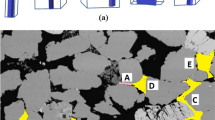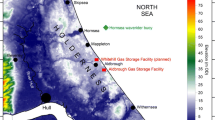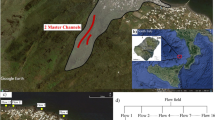Abstract
Tsunamis are unpredictable, catastrophic events, and so present enormous difficulties for direct studies in the field or laboratory. However, their sedimentary deposits yield evidence of a wide variety of hydrodynamic conditions caused by flow transformations on a spatial and temporal scale. Tsunami deposits ranging from the Miocene to modern times identified at different localities along the Chilean coast are described to provide a database of their characteristics. Among the typical features associated with tsunami deposits are well-rounded megaclasts eroded from coastal alluvial fans or beaches by very dense, competent flows. Sand injections from the base of these flows into the substrate indicate very high dynamic pressures, whereas basal shear carpets suggest hyperconcentrated, highly sheared flows. Turbulence develops in front of advancing debris flows, as indicated by megaflutes at the base of scoured channels.












Similar content being viewed by others
References
Bagnold RA (1954) Experiments on gravity-free dispersion of large solid spheres in a Newtonian fluid under shear. Roy Soc (Lond) Proc A 225:49–63
Bartsch-Winkler S, Schmoll HR (1993) Evidence for Late Holocene relative sea-level fall from reconnaissance stratigraphic studies in an area of earthquake-subsided intertidal deposits, Isla Chiloé, southern Chile. Special publication 20. International Association of Sedimentologists, pp 91–109
Cantalamessa G, Di Celma C (2005) Sedimentary features of tsunami backwash deposits in a shallow marine Miocene setting, Mejillones Peninsula, northern Chile. Sediment Geol 178:259–273
Cisternas M, Contreras I, Araneda A (2000) Reconocimiento y caracterización de la facies sedimentaria depositada por el tsunami de 1960 en el estuario Maullín. Rev Geol Chile 27:3–11
Comte D, Pardo M (1991) Reappraisal of great historical earthquakes in the Northern Chile and Southern Peru seismic gaps. Nat Hazards 4:23–44
Einsele G (1998) Event stratigraphy: recognition and interpretation of sedimentary event horizons. In: Doyle P, Bennett MR (eds) Unlocking the stratigraphic record: advances in modern stratigraphy. Wiley, Chichester, pp 145–193
Fisher RV (1983) Flow transformation in sediment gravity flows. Geology 11:273–274
Hartly A, Howell J, Mather ME, Chong G (2001) A possible Plio-Pleistocene tsunami deposit, Hornitos, northern Chile. Rev Geol Chile 28:117–125
Iverson RM, LaHusen RG (1989) Dynamic pore-pressure fluctuations in rapidly shearing granular materials. Science 346:796–799
Kelling G, Stanley DJ (1978) In: Stanley DJ, Kelling G (eds) Sedimentation in submarine canyons, fans and trenches. Dowden, Hutchinson & Ross, Inc., Stroudsburg, pp 377–388
Le Roux JP (1994) An alternative approach to the identification of sediment transport paths based on grain-size trends. Sediment Geol 94:97–107
Le Roux JP (2003) Can dispersive pressure cause inverse grading in grain flows?—discussion. J Sediment Res 73:331–332
Le Roux JP, O’Brien RD, Ríos F, Cisternas M (2002) Analysis of sediment transport paths using grain-size parameters. Comput Geosci 28:717–721
Le Roux JP, Gómez C, Fenner J, Middleton H (2004) Sedimentological processes in a scarp-controlled rocky shoreline to upper continental slope environment, as revealed by unusual sedimentary features in the Neogene Coquimbo Formation, north-central Chile. Sediment Geol 165:67–92
Massari F, D’Alessandro A (2000) Tsunami-related scour-and-drape undulations in Middle Pliocene restricted-bay carbonate deposits (Salento, south Italy). Sediment Geol 135:265–281
Middleton GV (1967) Experiments on density and turbidity currents—III: deposition of sediment. Can J Earth Sci 3:523–546
Minoura K, Nakaya S (1991) Traces of tsunami preserved in inter-tidal, lacustrine and marsh deposits: some examples from northeast Japan. J Geol 99:265–287
Mohrig D, Whipple KX, Hondzo M, Ellis C, Parker G (1998) Hydroplaning of subaqueous debris flows. Geol Soc Am Bull 110:387–394
Ortlieb L, Escribano R, Follegati R, Zuñiga O, Kong I, Rodríguez L, Valdés J, Guzmán N, Iratchet P (2000) Recording ocean-climate changes during the last 2,000 years in a hypoxic marine environment off northern Chile (23°S). Rev Chilena Hist Nat 73:221–242
Shiki T, Yamazaki T (1996) Tsunami-induced conglomerates in Miocene upper bathial deposits, Chita Peninsula, central Japan. Sediment Geol 104:175–188
Vargas G, Ortlieb L, Pichon JJ, Bertaux J, Pujos M (2004) Sedimentary facies and high resolution primary production inferences from laminated diatomaceous sediments off northern Chile (23°S). Mar Geol 211:79–99
Vargas G, Ortlieb L, Chapron E, Valdés J, Marquardt C (2005) Paleoseismic inferences from a high resolution marine sedimentary record in northern Chile (23°S). Tectonophysics (in press)
Watanabe T, Karzulovic J (1960) Los movimientos sísmicos del mes de mayo de 1960 en Chile. Universidad de Chile Anales 17:43–87
Wright C, Mella A (1963) Modifications of the soil pattern of south central Chile resulting from seismic and associated phenomena during the period May to August 1960. Seismol Soc Am Bull 53:1367–1402
Acknowledgements
This investigation was funded by Projects FONDECYT 1010691, PCCI CONICYT-IRD (Estudio Sísmico de Alta Resolución del Relleno Sedimentario Holoceno de la Bahía de Mejillones del Sur: Implicancias Neotectónicas y Océano-climáticas), PRODAC (Universidad de Chile), Programa de Cooperación Científica Internacional (Conicyt), and IRD (Paleótropique), which are gratefully acknowledged.
Author information
Authors and Affiliations
Corresponding author
Rights and permissions
About this article
Cite this article
Le Roux, J.P., Vargas, G. Hydraulic behavior of tsunami backflows: insights from their modern and ancient deposits. Environ Geol 49, 65–75 (2005). https://doi.org/10.1007/s00254-005-0059-2
Received:
Accepted:
Published:
Issue Date:
DOI: https://doi.org/10.1007/s00254-005-0059-2




